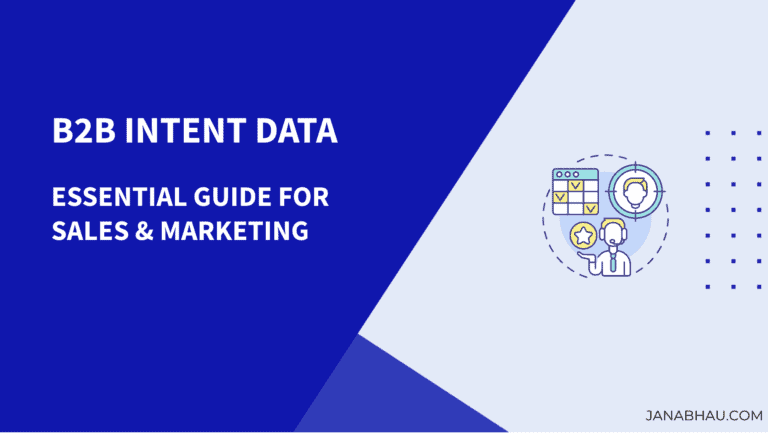18 Essential Account Based Marketing Metrics to Track in 2024

Account Based Marketing (ABM) has revolutionized B2B strategies, with 87% of marketers reporting higher ROI compared to traditional approaches.
As we navigate the complex B2B landscape of 2024, understanding and leveraging the right ABM metrics is crucial for optimizing performance and demonstrating value to stakeholders.
In this article, we’ll explore the essential account based marketing metrics that top-performing B2B companies use to measure success, drive growth, and improve ROI.
What Are Account Based Marketing Metrics?
Account-based Marketing metrics are engagement-based metrics that focus on specific accounts rather than broad audiences. They’re the numbers that tell us if we’re actually making progress with our target accounts or just spinning our wheels.
When we first started with ABM, we were so focused on getting campaigns out the door that we neglected to set up proper tracking. This was a big mistake. Without clear metrics, I had no idea if my efforts were paying off. It was like trying to navigate a ship without a compass.
Unlike traditional metrics that focus on overall website traffic or lead volume, we’re tracking things like engagement levels with key decision-makers at our target companies.
The importance of these metrics can’t be overstated. They help us understand which tactics are working, which accounts are warming up, and where we need to adjust our approach. Plus, they give us concrete data to show the higher-ups that our ABM efforts are worth the investment.
Key Performance Indicators (KPIs) for ABM Success
We’ve learned the hard way that not all KPIs are created equal in the world of Account Based Marketing. It’s tempting to track everything under the sun, but that’s a recipe for data overload and analysis paralysis.
The key to ABM success is aligning your KPIs with your business objectives.
Are you trying to break into new enterprise accounts?
Focus on metrics like account penetration and engagement scores.
Looking to expand existing relationships?
Keep an eye on customer lifetime value and cross-sell opportunities.
One of our biggest “aha” moments came when we realized the power of sales and marketing alignment in choosing KPIs. I used to pick metrics that made marketing efforts look good, but didn’t necessarily translate to revenue. Now, we ework closely with our sales team to identify KPIs that truly matter to the bottom line.
Some essential ABM KPIs I’ve found invaluable include:
- Account engagement score
- Pipeline velocity for target accounts
- Win rate for ABM-influenced deals
- Marketing-qualified accounts (MQAs)
Ultimately, the best KPIs are the ones that help you make informed decisions and drive real business growth. Keep it simple, keep it relevant, and always tie it back to your overall objectives.
In this article, I will focus on the different segment of metrics based on intents such as engagement, revenue, sales and marketing alignment, and more.
Engagement Metrics: To measure interactions with target accounts

Engagement metrics are crucial to understand how our target accounts interact with our brand. They provide insights into which accounts are most interested and help us tailor our approach. Let’s dive into the key metrics I’ve found most valuable in my ABM journey.
1. Account Engagement Score
The account engagement score shows us how interested an account is in our products or services. It’s a cumulative score based on previous interactions, such as website visits, content downloads, or demo requests.
Here’s how I calculate account engagement score:
Account Engagement Score = Σ(Interaction Value × Interaction Count)
For example:
- Page view: 1 point
- Content download: 5 points
- Demo request: 10 points
So if an account has 10 page views, 2 content downloads, and 1 demo request, their score would be: (1 × 10) + (5 × 2) + (10 × 1) = 30
Most marketing automation platforms allow you to set up these rules and definitions to prioritize accounts. Using this score, we can identify which accounts our sales team should focus on first.
2. Website Visits from Target Accounts
Tracking website visits from target accounts gives us insight into their research process. I use Leadfeeder for this, which integrates with our CRM to identify companies based on IP addresses.
To measure this effectively, I look at:
- Number of unique visitors from the account
- Number of pages visited per session
- Time spent on site
An increase in these metrics often signals that an account is moving closer to a purchasing decision.
3. Content Engagement Rates
Content engagement rate helps us understand which materials resonate with our target accounts. I calculate it like this:
Content Engagement Rate = (Number of Engagements / Number of Content Pieces Served) × 100
For example, if we served 10 pieces of content to an account and they engaged with 4, the rate would be 40%.
Tagging content with account-specific UTM parameters helps me track content better. This metric guides our content creation strategy, showing us what topics and formats work best for each account.
4. Email Open and Click-Through Rates
These metrics are critical for measuring the effectiveness of our personalized ABM email outreach. Here’s how I calculate them:
- Open Rate = (Number of Emails Opened / Number of Emails Delivered) × 100
- Click-Through Rate = (Number of Clicks / Number of Emails Opened) × 100
For instance, if we sent 100 emails, 50 were opened, and 10 were clicked: Open Rate = (50 / 100) × 100 = 50% Click-Through Rate = (10 / 50) × 100 = 20%
I use email marketing automation platforms, such as HubSpot, to track these ABM metrics. Low email related rates often indicate a need to refine our messaging or segmentation for specific accounts.
Pipeline Metrics: To track account progress across stages

Pipeline metrics are crucial to understand how effectively your target accounts move through the sales process. They help us identify bottlenecks and optimize our sales approach. My team can easily track these metrics using the data on a CRM and creating focused reports for ABM campaigns.
5. Account Penetration Rate
This metric shows how deeply we’ve penetrated a target account’s decision-making unit. As this rate increases, it indicates that we’ve been able to reach most of the key stakeholders.
Account Penetration Rate = (Number of Engaged Contacts / Total Known Contacts in Account) × 100
This insight can drive us to expand our outreach strategies or refine our contact list for the account.
6. Opportunity Creation Rate
This ABM metric is a reflection of how many engaged accounts get converted into actual sales opportunities.
Opportunity Creation Rate = (Number of Opportunities Created / Number of Engaged Accounts) × 100
A low rate could suggest issues with our qualification process or value proposition. It might prompt us to reassess our engagement tactics or refine our messaging to better address account pain points.
7. Deal Velocity for Target Accounts
Deal velocity shows how quickly we’re moving opportunities through our pipeline. We can use this information to identify and address bottlenecks, potentially through additional content, sales or buyer enablement, or process refinement.
Deal Velocity = (Number of Deals × Average Deal Value) / Average Sales Cycle Length (in days)
8. Win Rate for ABM-Influenced Deals
A win rate indicates how well your ABM strategy is converting high-value target accounts into customers. If your overall win rate is lower in ABM vs non-ABM deals or has not improved over time, you might want to reassess your account selection criteria or sales approach for ABM accounts.
Win Rate = (Number of Won Deals / Total Number of Closed Deals) × 100
Pro Tip: Since these metrics show the lead’s movement across the pipeline, it’s important to monitor them on a weekly or bi-monthly basis. Ready-to-use dashboards on CRMs are your best choice in this case.
Revenue Metrics: To measure the financial impact

Revenue metrics are calculated in ABM (Account-Based Marketing) to measure the direct financial impact of your targeted approach. They provide insights into how effectively your ABM strategy is driving revenue growth and return on investment (ROI).
9. Customer Lifetime Value (CLV)
This metric shows the total revenue we expect from a customer over our entire relationship. We calculate it to understand the long-term value of our ABM efforts. I use Gainsight to track CLV, combining purchase history with predictive analytics.
Customer Lifetime Value = (Average Purchase Value × Purchase Frequency × Customer Lifespan)
Don’t just look at the overall CLV. Break it down by industry or account size. I once discovered a goldmine segment this way!
10. Average deal size for ABM opportunities
This measures the typical value of deals influenced by our ABM strategies. It’s crucial for justifying the resources we pour into ABM. I track this in Salesforce, tagging deals as ABM-influenced.
Average deal size = Total Value of ABM Deals ÷ Number of ABM Deals
11. Return on Investment (ROI) for ABM Campaigns
ROI is critical for justifying our ABM spend. Here’s how I calculate it:
ROI = ((Total Revenue from ABM – Total Cost of ABM) / Total Cost of ABM) × 100
For instance, if we spend $100,000 on ABM and generate $500,000 in revenue: ((500,000 – 100,000) / 100,000) × 100 = 400% ROI
I use a combination of our CRM, marketing automation platform, and financial data to track this. A positive ROI is crucial for continued support of ABM initiatives.
12. Revenue Contribution from ABM Initiatives
This metric shows how significant ABM is to our overall revenue generation. It reflects how effective your account based marketing strategies have been and can help you compare it against other marketing channels.
You can choose to analyze the revenue contribution on an account-level, to gauge targeting and campaign effectiveness.
Revenue Contribution = (Revenue from ABM Deals / Total Company Revenue) × 100
A growing percentage can justify expanding our ABM program. If it’s stagnant or declining, we might need to reassess our account selection or expand our ABM approach to more accounts.
Account Coverage and Reach Metrics: To evaluate market penetration and target accuracy

So, you’ve got your ABM campaign up and running. But how do you know if you’re actually hitting the right people? That’s where account coverage and reach metrics come in. These metrics give you a clear picture of who you’re reaching and how far your message is spreading.
13. Target account list coverage
This metric shows how many of our target accounts we’re actively engaging. I calculate it as:
Target Account List Coverage = (Number of Engaged Target Accounts / Total Number of Target Accounts) × 100
If the target account list coverage is low, we need to diversify our outreach tactics or reassess our target account list. I use an ABM platform like 6sense or Terminus to monitor engagement across target accounts.
14. Marketing-qualified accounts (MQAs)
This metric indicates how many accounts are showing sufficient engagement to be passed to sales. It can guide adjustments to our content strategy or lead nurturing processes.
MQA Rate = (Number of MQAs / Total Number of Target Accounts) × 100
You can use your marketing automation platform (e.g., Marketo, HubSpot) to set MQA criteria and track qualification rates.
15. Sales and marketing alignment score
The alignment between marketing and sales teams is often a qualitative metric, but I’ve found a way to quantify it:
Alignment Score = ((% of MQAs Accepted by Sales + % of Sales Opportunities Influenced by Marketing) / 2) × 100
If sales accepts 80% of MQAs and marketing influences 70% of opportunities: ((80 + 70) / 2) × 100 = 75% alignment score
I gather this data from our CRM and regular sales-marketing meetings. If this score dips below a certain mark, it indicates that we need to improve communication and processes between teams.
Account Awareness and Perception Metrics: To gauge how your audience sees you

One of the most important aspects of ABM is building strong relationships with our target accounts. But how do we know if we’re making a real impact? That’s where account awareness and perception metrics come in.
These metrics help us understand how well our target accounts know and feel about our brand. We typically measure them using surveys and third-party tools, like Qualtrics, or social listening tools, like Hootsuite.
16. Brand Awareness
Brand consideration measures how seriously target accounts are considering your brand as a potential solution to their needs. It’s a crucial metric because it indicates the progress of your ABM efforts in positioning your brand as a preferred choice.
To quantify brand awareness, you need to figure out the percentage of target accounts who are familiar with your brand.
17. Brand Consideration
Are they thinking of us when they need a solution like ours?
Brand consideration can be measured through surveys and interviews with target accounts. Ask questions about their awareness of your brand, their perception of your offerings, and whether they would consider purchasing from you.
You can also use customer relationship management (CRM) data to track the number of target accounts that have engaged with your sales team.
18. Net Promoter Score (NPS)
NPS is a loyalty metric that measures how likely target accounts are to recommend your brand to others. It’s a valuable indicator of customer satisfaction and brand advocacy.
A high NPS suggests that your ABM efforts have created strong relationships and positive experiences for your target accounts.
How should it be calculated?
NPS is calculated by asking target accounts a single question: “On a scale of 0 to 10, how likely are you to recommend [company name] to a friend or colleague?” Those who score 9 or 10 are considered “promoters,” while those who score 0 to 6 are considered “detractors.”
NPS = % of promoters – % of detractors
When these metrics improve over time, it means we’re successfully building our brand among the accounts that matter most. By tracking them alongside other metrics like pipeline, revenue, and account coverage, we can get a complete picture of how our ABM strategy is working and make adjustments as needed.
Conclusion and My Experience
Measuring ABM metrics can be a real headache. I’ve spent countless hours wrestling with data, trying to prove ABM’s worth. It’s not easy, but it’s crucial.
Data silos are a major pain point. Getting marketing and sales data to align feels like herding cats sometimes. Attribution is another tricky beast. With long sales cycles and multiple touchpoints, pinpointing what truly influenced a deal can be a guessing game.
Then there’s the qualitative vs. quantitative dilemma. How do you measure improved relationships? It’s not always cut and dry.
I’ve found that a centralized ABM platform can be a game-changer. Tools like CRM platforms, marketing automation tools, or ABM specific platforms, like Demandbase or 6sense, offer comprehensive solutions that tackle these challenges head-on.
They integrate data across systems, provide multi-touch attribution models, and offer AI-powered insights for both quantitative and qualitative metrics.
But, remember that perfect measurement is a myth. Start with the metrics that matter most to your business and build from there. It’s a journey, but one that’s worth the effort.
With the right tools and mindset, you can turn these challenges into opportunities for deeper insights in 2024.






